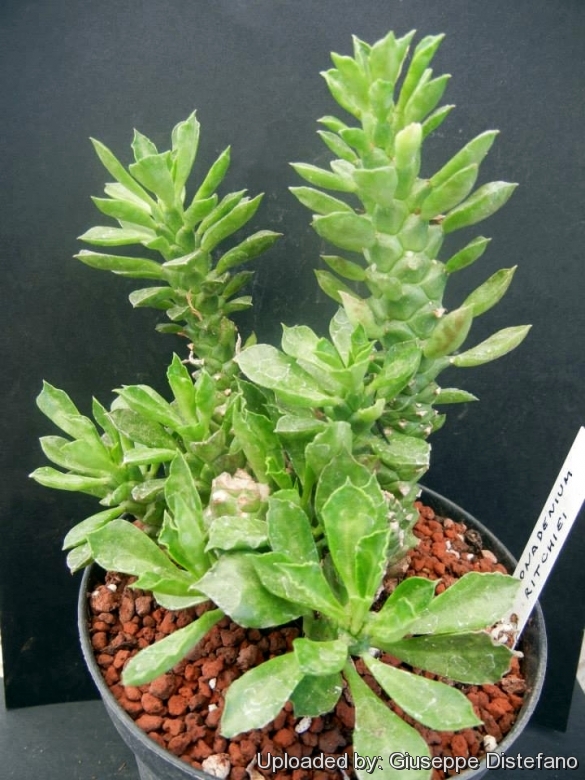
Euphorbia ritchiei Photo by: Giuseppe Distefano
Origin and Habitat: Origin and Habitat: Eastern Africa, Kenya (Meru Distr. SW. of Isiolo)
Type locality: Kenya, Meru District, 12 km. SW. of Isiolo.
Altitude range: c. 1300 metres above sea level.
Habitat: Steep stony slopes with some water in summer and none in winter.
Synonyms:
See all synonyms of Euphorbia ritchiei
Common Names include:
JAPANESE (日本語): リチェイ
Subspecies, varieties, forms and cultivars of plants belonging to the Monadenium ritchiei group
 Euphorbia ritchiei (P.R.O.Bally) Bruyns: (subsp. ritchiei) has longer pale green, decumbent stems to 60 cm tall and 3 cm wide with tubercles in loosely spiralled series. Has puberulous leaves. Bract-cup greyish green. Distribution: Meru District. SW. of Isiolo.
Euphorbia ritchiei (P.R.O.Bally) Bruyns: (subsp. ritchiei) has longer pale green, decumbent stems to 60 cm tall and 3 cm wide with tubercles in loosely spiralled series. Has puberulous leaves. Bract-cup greyish green. Distribution: Meru District. SW. of Isiolo.- Euphorbia ritchiei subs. marsabitensis (S.Carter) Bruyns: has darkish green stems, branching from the base, rhizomatous and decumbent to 25 cm long and only 2 cm thick. Leaves puberolous. Distribution: Kenya. Northern Frontier Province: Marsabit.
 Euphorbia ritchiei subs. nyambensis (S.Carter) Bruyns: is a dwarf subspecies with short, very knobby pale green stems, erect to 15 cm high and to 3 cm thick. Leaves glabrous. Bract-cup and cyathia entirely deep pink. Distribution: Meru Distr. NE end of Nyambeni Hills, lagadema Hill.
Euphorbia ritchiei subs. nyambensis (S.Carter) Bruyns: is a dwarf subspecies with short, very knobby pale green stems, erect to 15 cm high and to 3 cm thick. Leaves glabrous. Bract-cup and cyathia entirely deep pink. Distribution: Meru Distr. NE end of Nyambeni Hills, lagadema Hill.
Bibliography: Major references and further lectures
1) A. R. Smith, Susan Carter “Flora of Tropical East Africa - Euphorbiaceae” volume 2 CRC Press, 01/Jun/1988
2) Urs Eggli “Illustrated Handbook of Succulent Plants: Dicotyledons” Springer, 2002
3) Arthur John Jex-Blake “Gardening in East Africa: A Practical Handbook” Longmans, Green, 1957
4) Alain Campbell White, Robert Allen Dyer, Boyd L. Sloane “The succelent Euphorbisae (southern Africa)” Abbey garden press, 1941
Cultivation and Propagation: Monadenium ritchieiSN|12111]]SN|12111]] is easy to grow, it spreads by underground shoots and forms large clumps with time and therefore requires a broader pot. It must be grown very hard in the nursery as close to the natural conditions as possible. This ensures that it keeps its compact habit. It will shed leaves quickly with changes in light and when conditions become dry (Don't panic its normal!)
Soil: It does best in a mineral soil, but is tolerant of a wide range of soil types. Good drainage is essential. In pots give the plant an airy growing medium which mainly consists of non organic material such us clay, pumice, lava grit, and only a little peat or leaf-mould.
Repotting: Repott every two years in very later winter, early spring.
Watering: Water sparingly from March to September. No water should ever be allowed to stand around the roots. Keep almost completely dry in winter.
Frost tolerance: Due to its African origin it cannot tolerate freezing temperature but should be able to handle 7 degrees Celsius very easily. However, that species seems to hate being wet for any extended period and rot easily especially in winter if overwatered.
Rot: Rot it is only a minor problem with Monadeniums if the plants are watered and “aired” correctly. If they are not, fungicides won't help all that much.
Sun Exposure: Light shade, but can tolerate a sunny position, and a plant that has been growing in shade should be slowly hardened off before placing it in full sun as the plant will be severely scorched if moved too suddenly from shade into sun.
Propagation: The plant can be reproduced by seeds or cuttings. If you remove an offset, remember to let it dry for some days, letting the wound heal (cuttings planted too soon easily rot before they can grow roots). Lay it on the soil and insert the stem end partially into the substrate. Try to keep the cutting somewhat upright so that the roots are able to grow downward.











